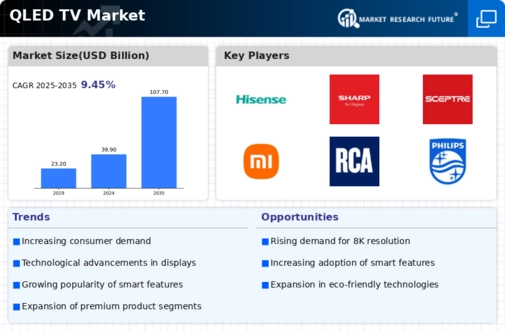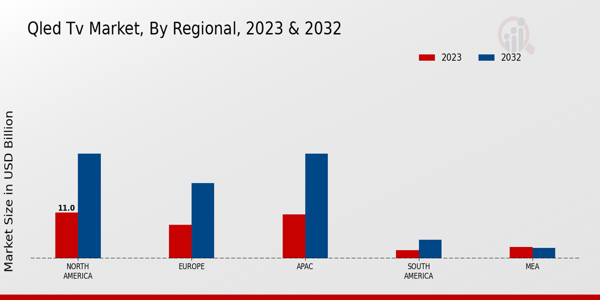Market Growth Projections
The Global QLED TV Market Industry is poised for substantial growth, with projections indicating a market value of 39.9 USD Billion in 2024 and an anticipated increase to 107.7 USD Billion by 2035. This growth trajectory, characterized by a compound annual growth rate of 9.45% from 2025 to 2035, reflects the increasing consumer preference for high-quality display technologies. The market's expansion is likely driven by technological advancements, rising disposable incomes, and the growing availability of premium content. As these factors converge, the QLED TV market is expected to evolve, presenting opportunities for manufacturers and stakeholders alike.
Increasing Adoption of Smart TVs
The increasing adoption of smart TVs significantly influences the Global QLED TV Market Industry. As consumers gravitate towards connected devices, QLED TVs equipped with smart features, such as streaming capabilities and voice control, become increasingly desirable. This shift aligns with the broader trend of digitalization in households, where smart home integration is becoming commonplace. The convenience and versatility offered by smart QLED TVs are likely to drive sales, contributing to a projected compound annual growth rate of 9.45% from 2025 to 2035. This growth reflects the market's adaptation to evolving consumer preferences and technological advancements.
Rising Disposable Income and Urbanization
Rising disposable income and urbanization are key factors propelling the Global QLED TV Market Industry. As more individuals attain higher income levels, there is a noticeable shift towards premium products, including QLED TVs. Urbanization also plays a crucial role, as urban dwellers tend to prioritize advanced technology in their homes. This demographic shift is likely to increase the demand for high-end televisions, with consumers willing to invest in superior display technology. The combination of these economic factors suggests a favorable environment for QLED TV sales, contributing to the overall growth trajectory of the market.
Technological Advancements in QLED Technology
Technological advancements play a pivotal role in shaping the Global QLED TV Market Industry. Innovations such as quantum dot technology enhance color reproduction and energy efficiency, making QLED TVs more appealing to consumers. As manufacturers invest in research and development, the introduction of features like 8K resolution and improved HDR capabilities is anticipated to attract tech-savvy buyers. The continuous evolution of QLED technology not only enhances user experience but also positions the market for substantial growth, with projections indicating a market value of 107.7 USD Billion by 2035. This trajectory underscores the potential for sustained innovation in the industry.
Rising Consumer Demand for High-Quality Displays
The Global QLED TV Market Industry experiences a surge in consumer demand for high-quality displays, driven by advancements in display technology. As consumers increasingly seek superior picture quality, QLED TVs, with their enhanced color accuracy and brightness, become a preferred choice. This trend is reflected in the projected market value of 39.9 USD Billion in 2024, indicating a robust interest in premium television options. The appeal of QLED technology, which offers better performance compared to traditional LED TVs, suggests that manufacturers are likely to focus on innovation to meet consumer expectations, thereby propelling market growth.
Growing Entertainment Industry and Content Availability
The growth of the entertainment industry, coupled with the availability of high-quality content, serves as a significant driver for the Global QLED TV Market Industry. As streaming platforms expand their offerings, consumers are increasingly seeking televisions that can deliver an immersive viewing experience. QLED TVs, known for their superior picture quality, are well-positioned to meet this demand. The proliferation of 4K and 8K content further enhances the appeal of QLED technology, as consumers desire devices that can fully utilize these advancements. This trend is expected to bolster market growth, as more households invest in QLED TVs to enhance their home entertainment experience.













